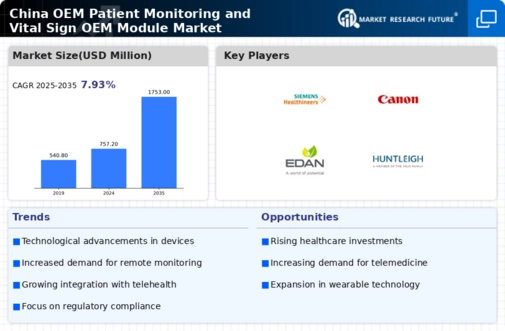Aging Population
China's demographic shift towards an aging population significantly influences the oem patient-monitoring-vital-sign-oem-module market. By 2025, it is estimated that over 300 million individuals will be aged 60 and above, necessitating enhanced healthcare services. This demographic trend creates a heightened demand for patient monitoring solutions that can effectively track vital signs and manage chronic conditions prevalent among older adults. Healthcare facilities are increasingly investing in these technologies to ensure timely interventions and improve the quality of care. The growing prevalence of age-related health issues, such as cardiovascular diseases and diabetes, further drives the need for reliable monitoring systems, positioning the oem patient-monitoring-vital-sign-oem-module market for substantial growth.
Rising Healthcare Expenditure
The increasing healthcare expenditure in China is a pivotal driver for the oem patient-monitoring-vital-sign-oem-module market. As the government allocates more funds towards healthcare, the demand for advanced medical technologies rises. In 2025, healthcare spending is projected to reach approximately $1 trillion, reflecting a growth rate of around 10% annually. This surge in investment facilitates the adoption of innovative patient monitoring solutions, enhancing the capabilities of healthcare providers. Consequently, hospitals and clinics are more inclined to integrate sophisticated monitoring modules into their systems, thereby propelling the market forward. The emphasis on improving patient outcomes and operational efficiency further underscores the importance of these modules in modern healthcare settings.
Focus on Preventive Healthcare
The shift towards preventive healthcare in China is emerging as a significant driver for the oem patient-monitoring-vital-sign-oem-module market. With an increasing awareness of health management, both patients and healthcare providers are prioritizing early detection and prevention of diseases. This trend is reflected in the growing adoption of monitoring systems that facilitate continuous health tracking. By 2025, it is anticipated that the preventive healthcare market will grow by approximately 15%, highlighting the rising demand for effective monitoring solutions. As healthcare systems emphasize proactive approaches, the oem patient-monitoring-vital-sign-oem-module market is positioned to benefit from this paradigm shift, as these modules play a critical role in enabling preventive care.
Government Initiatives and Policies
Government initiatives and policies aimed at enhancing healthcare infrastructure are vital drivers for the oem patient-monitoring-vital-sign-oem-module market. The Chinese government has implemented various programs to improve healthcare access and quality, including investments in medical technology. In 2025, the government is expected to allocate significant resources towards upgrading healthcare facilities, which will likely include the procurement of advanced monitoring systems. These initiatives not only support the growth of the oem patient-monitoring-vital-sign-oem-module market but also encourage local manufacturers to innovate and compete. The alignment of government policies with market needs creates a conducive environment for the expansion of patient monitoring solutions.
Technological Integration in Healthcare
The integration of advanced technologies in healthcare is a crucial driver for the oem patient-monitoring-vital-sign-oem-module market. Innovations such as artificial intelligence (AI), machine learning, and the Internet of Things (IoT) are transforming patient monitoring systems. In 2025, the market for AI in healthcare is expected to exceed $6 billion, indicating a robust trend towards smart healthcare solutions. These technologies enhance the accuracy and efficiency of monitoring vital signs, enabling healthcare providers to deliver personalized care. As hospitals and clinics adopt these integrated systems, the demand for oem patient-monitoring-vital-sign-oem-module market solutions is likely to increase, fostering a competitive landscape among manufacturers.















Leave a Comment